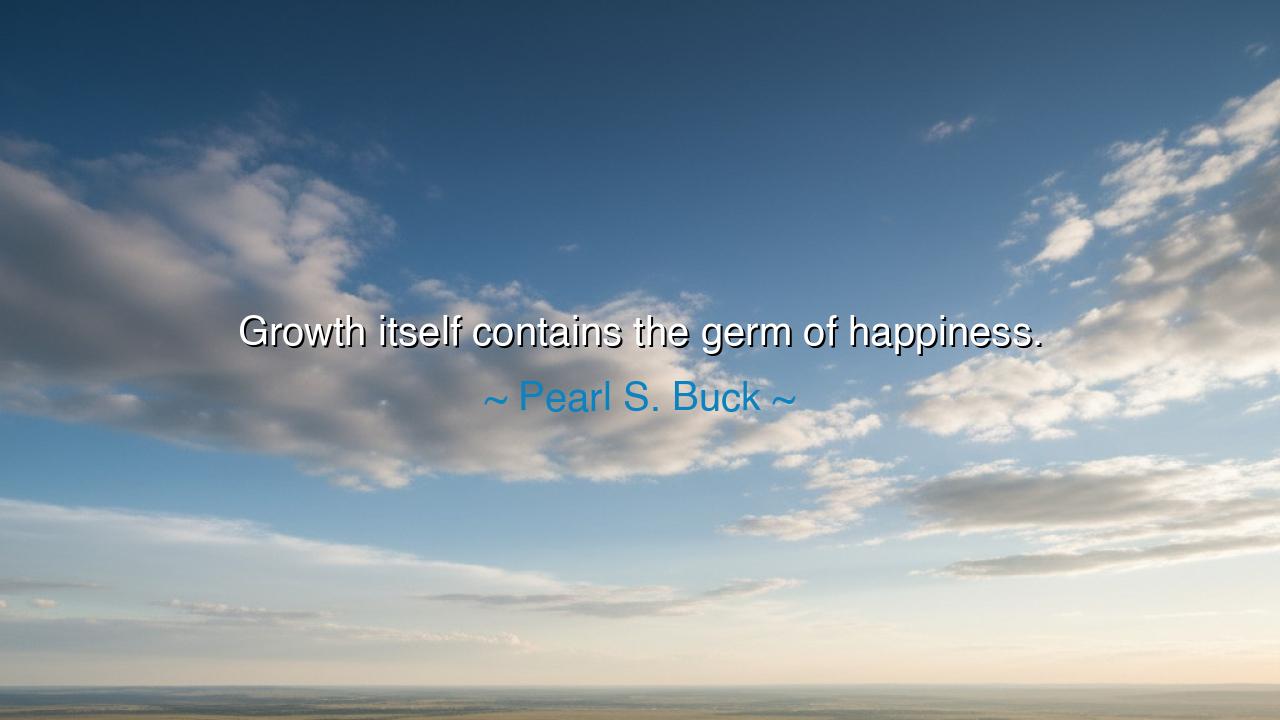
Growth itself contains the germ of happiness.






"Growth itself contains the germ of happiness." So spoke Pearl S. Buck, the great chronicler of human struggle and the quiet majesty of endurance. In these few words lies a truth as ancient as the soil from which all life springs: that joy is not found in comfort, but in becoming. For to grow is to change, to strive, to reach beyond what we were yesterday. Within that striving lies the seed—the germ—of something far greater than pleasure: the sacred satisfaction of the soul that knows it is alive and unfolding toward its purpose.
Growth is not the easy path. It comes with pain, uncertainty, and loss. Yet it is through these very trials that life awakens. The tree must push through dark earth before it can reach the sun. The muscle must tear before it strengthens. The spirit must face doubt before it gains wisdom. Buck, who lived between worlds—an American born in China, a woman of letters in an age of silence—knew that life’s deepest happiness does not come from having, but from becoming. To grow, she teaches us, is to honor the rhythm of life itself: to struggle, to endure, to rise again.
Consider the life of Helen Keller, who as a child was struck blind and deaf, cast into a world of silence and isolation. Yet within her, the germ of growth still stirred. Guided by her teacher, Anne Sullivan, she fought through the darkness to learn language, then thought, then understanding. She grew not in body alone, but in mind and spirit. In her later years, Keller said that “character cannot be developed in ease and quiet,” echoing Buck’s eternal insight. Her growth—her refusal to yield to limitation—became her happiness, not because life was easy, but because it was meaningful.
The ancients, too, knew this truth. The Stoics spoke of the inner citadel, the strength that grows only through adversity. The Buddha taught that enlightenment itself is a form of growth—an unfolding of awareness from ignorance to insight. Even the heroes of old, from Odysseus to Arjuna, found joy not at the end of their trials, but through the journey itself. For every hardship faced in courage awakens a deeper self, and every ascent, no matter how slow, nourishes the germ of happiness that lies dormant in all living souls.
Pearl S. Buck wrote during a time of upheaval—wars, revolutions, and shifting empires. Yet her stories spoke not of despair, but of renewal. She saw in the common peasant, in the mother tilling the land or the child learning his first word, a quiet growth that defied the ruins of circumstance. She believed that to live fully was to accept the call to change—to expand one’s compassion, to deepen one’s understanding, to rise beyond one’s fears. In every step forward, however small, she found the spark of joy that no stagnation could offer.
The lesson she leaves us is both simple and profound: seek growth, not ease. When life challenges you, do not curse the pain; it is the soil in which your better self takes root. When you fail, do not despair; failure is the shadow that defines the light of progress. And when you feel lost, remember that every wandering path still leads toward learning. The germ of happiness lives not in arrival, but in the sacred motion of becoming more than you were.
So, my children of tomorrow, do not chase happiness as a butterfly that flits beyond reach. Tend instead the garden of your soul. Learn, change, and grow. Let your struggles carve you into wisdom, and let your victories humble you into gratitude. For as Pearl S. Buck revealed, the germ of happiness is not something found outside the self—it is the living seed planted deep within, awakened each time you rise, evolve, and continue the journey of becoming. In growth, there is not only life, but joy everlasting.






AAdministratorAdministrator
Welcome, honored guests. Please leave a comment, we will respond soon